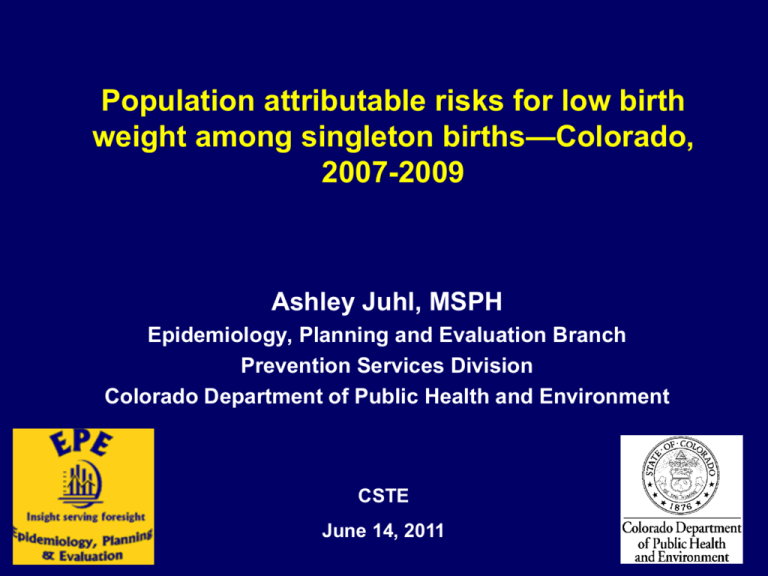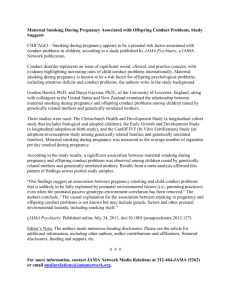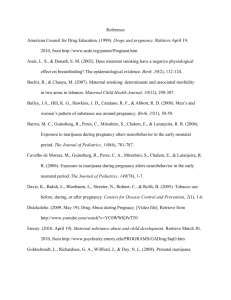Open
advertisement

Population attributable risks for low birth weight among singleton births—Colorado, 2007-2009 Ashley Juhl, MSPH Epidemiology, Planning and Evaluation Branch Prevention Services Division Colorado Department of Public Health and Environment CSTE June 14, 2011 Outline • • • • • • Background on low birth weight Purpose of this analysis Methods for this analysis Results of the analysis Discussion of analysis results Recommendations based on the results Background and Purpose Background • 2009 low birth weight rate in Colorado = 8.8% • Preliminary 2009 low birth weight rate for the • United States = 8.2% Low birth weight outcomes – Neonatal mortality and morbidity – Long-term developmental and neurological disabilities and complications Background • Known risk factors for low birth weight – – – – Maternal smoking Maternal alcohol consumption Maternal age (<15 years and 35+ years) Weight gain below the recommended range based on prepregnancy BMI category (inadequate weight gain) – Previous preterm birth – Social and economic factors (low income, low educational level, stress, unmarried, domestic violence or abuse) – Infections and placental problems Previous Colorado Study 1995-1997 • Population attributable risk analysis among singleton births • Inadequate weight gain during pregnancy (1 in 8 low weight births) • Smoking during pregnancy (1 in 8 low weight births) • Inadequate weight gain and/or smoking (1 in 3 low weight births) http://www.cdphe.state.co.us/pp/womens/pdf/tippingthescales.pdf Purpose • To determine if the same risk factors still contribute to low birth weight among singletons Methods Methods • Colorado birth certificates 2007-2009 – Cross-sectional study of a birth cohort – Live births to Colorado residents – Singletons only (N=202,498) Variables • Outcome of interest – Low birth weight • <2,500 grams (5 lbs, 8 oz or less) Variables • Risk factors – Inadequate maternal weight gain • Based on 1990 IOM recommendations – Smoking during pregnancy – Premature rupture of the membranes – Pregnancy induced hypertension or eclampsia – Abruptio placenta – Short interpregnancy interval (<12 months between previous delivery and subsequent conception) – No prenatal care – Placenta previa – Altitude > 10,000 feet (maternal residence at birth) Variables (continued) • Combined risk factor – Mothers gain inadequately OR mothers smoke OR mothers gain inadequately and smoke Analysis Steps Step 1. Calculated the prevalence of each risk factor in the population Step 2. Calculated low birth weight rate for each risk factor Step 3. Calculated relative risks (RR) and 95% confidence intervals for each risk factor Step 4. Calculated population attributable risk (PAR) percent and 95% confidence intervals for each risk factor Results Maternal Characteristics Colorado 2007-2009 Singleton Births Age (years) <18 Mothers (%) N=202,498 6,499 (3.2) 18-19 12,907 (6.4) 20-24 46,456 (22.9) 25-29 56,516 (27.9) 30-34 48,695 (24.0) 35+ 31,408 (15.5) Maternal Characteristics Colorado 2007-2009 Singleton Births Race/Ethnicity Mothers (%) N=202,498 White, non Hispanic 119,210 (58.9) White, Hispanic 55,949 (27.6) Black 9,680 (4.8) Asian American/Pacific Islander 7,124 (3.5) American Indian/Native Alaskan 2,061 (1.0) Step 1. Prevalence Colorado 2007-2009 Singleton Births Risk Factor Prevalence Inadequate weight gain and/or smoking 26.2% Inadequate weight gain during pregnancy 18.7% Short interpregnancy interval 16.2% Smoking during pregnancy 8.7% Pregnancy induced hypertension or eclampsia 3.5% Premature rupture of the membranes 2.5% No prenatal care 1.5% Abruptio placenta, placenta previa, and altitude >10,000 feet each had prevalence below 1%. Step 2. Low Birth Weight (LBW) Rate Colorado 2007-2009 Singleton Births Risk Factor LBW Rate Premature rupture of the membranes 36.9% No prenatal care 21.0% Pregnancy induced hypertension or eclampsia 20.6% Smoking during pregnancy 12.2% Inadequate weight gain during pregnancy 10.5% Inadequate weight gain and/or smoking 10.4% Short interpregnancy interval 6.9% Colorado singleton low birth weight rate = 7.0% Step 3. Relative Risks (RR) for Low Birth Weight Colorado 2007-2009 Singleton Births Risk Factor RR (95% CI) Premature rupture of the membranes 5.91 (5.68-6.15) No prenatal care 3.26 (3.03-3.50) Pregnancy induced hypertension or eclampsia 3.14 (2.99-3.30) Inadequate weight gain and/or smoking 1.91 (1.85-1.98) Smoking during pregnancy 1.87 (1.79-1.95) Inadequate weight gain during pregnancy 1.79 (1.73-1.86) Short interpregnancy interval 1.15 (1.08-1.22) Step 4. Population Attributable Risks (PAR) for Low Birth Weight Colorado 2007-2009 Singleton Births Risk Factor PAR (95% CI) Inadequate weight gain and/or smoking 19.4% (18.2-20.5) Inadequate weight gain during pregnancy 12.9% (12.0-13.9) Premature rupture of the membranes 11.1% (10.5-11.6) Smoking during pregnancy 7.1% (6.4-7.7) Pregnancy induced hypertension or eclampsia 6.9% (6.4-7.4) No prenatal care 4.2% (3.7-4.6) Short interpregnancy interval 2.4% (1.3-3.4) Discussion and Recommendations Discussion • Inadequate maternal weight gain: 1 in every 8 low weight births • Smoking during pregnancy: 1 in every 14 low weight births • Compared to the 1995-1997 study, no change in inadequate weight gain contribution, but a large drop in smoking contribution • Smoking prevalence declined 25% Conclusions • Inadequate weight gain and smoking during • • pregnancy still contribute to low birth weight Prevalence of smoking during pregnancy declined which decreased its contribution to low birth weight Public health implication – If programmatic efforts move pregnant women towards adequate weight gain and increase smoking cessation prior to conception, low birth weight births could be reduced. – Hypothetical state low birth weight rate = 7.5% • Actual 2009 LWB rate = 8.8% Strengths & Limitations • Strengths – Large birth cohort to study • Able to stratify • Limitations – Not all LBW risk factors are included on birth certificate • Example: maternal stress Recommendations for Colorado • Continue to – Counsel women on smoking cessation before conception and during pregnancy – Encourage women to gain an adequate amount of weight during pregnancy Recommendations for All Future Tasks • Focus public health efforts to improve • preconception and interconception health Opportunities for program collaboration Acknowledgments • Colorado Department of Public Health and Environment – Barbara Gabella. MSPH – Indira Gujral, MS, PhD – Sue Ricketts, MA, PhD – Linda Archer, MSN, RN, CNS – Mandy Bakulski, RD – Kirk Bol, MSPH – Epidemiology, Planning and Evaluation Branch • The Prenatal Program of the Women's Health Section and Grant Number B04MC17035 from the Maternal and Child Health Bureau (Title V, Social Security Act), Health Resources and Services Administration, Department of Health and Human Services supports this project. The findings and conclusions in this presentation are those of the author(s) and do not necessarily represent the views of the Colorado Department of Public Health and Environment. Thank You Questions & Comments ashley.juhl@state.co.us References • • • • Births: Preliminary data for 2009. National Center for Health Statistics. Ricketts S, Trierweiler K, Colorado. Dept. of Public Health and Environment. Tipping the scales : weighing in on solutions to the low birth weight problem in Colorado. Denver, Colo. (4300 Cherry Creek Drive South, Denver 80246): Colorado Dept. of Public Health & Environment; 2000. Colorado Birth Certificates, Vital Statistics Section, Colorado Department of Public Health and Environment. Centers for Disease Control. National Environmental Public Health Tracking Network. http://ephtracking.cdc.gov/showIndicatorsData.action.






